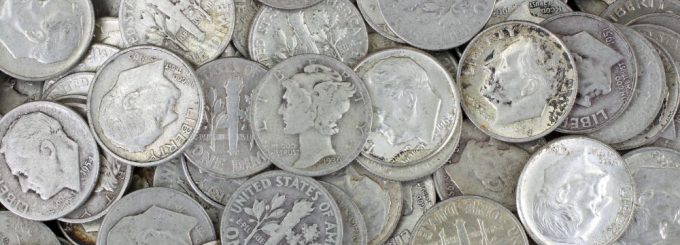1877 CC Seated Liberty Dime Silver Review

The Seated Liberty Dime is one of the most famous U.S. silver coins and was produced for about fifty years. They were issued by mints in multiple areas, including New Orleans, Carson City, Philadelphia and San Francisco.
Features
The obverse side of the coin shows a portrait of Liberty who is sitting on a rock. In one hand she has a shield while in the other there is a pole featuring the freedom cap. The reverse side shows a simple laurel wreath. Because it was minted for so many years, it has gone through a number of alterations.
The value for a Liberty Seated Dime will vary depending on the year in which it was minted and the edition along with the condition. For example, an Obverse Legend edition which is in excellent quality can be sold for ten dollars per coin, while the No Stars variant which is in an uncirculated state can go for as much as $741 for a single coin. If you are in possession of a coin that you believe to be rare, you should have it graded by either the NGC or PCGS.
Background
Silver coins were produced in the United States for many years and at various points the country was under a silver standard. The most popular silver coins were struck by the Carson City mint in Nevada, and are often given the CC designation to separate them from coins produced by other mints. The 1877 Seated Liberty Dime is one such coin and has its original light grey and white tone, with excellent luster when exposed to light. About 7.7 million of these coins were originally produced, and the high issue was considered standard for multiple grades, especially MS 66.
The silver standard first appeared in the U.S. during 1785. The Mint and Coinage Act was used to codify it in 1792, and the federal government would use the Bank of the United States to maintain silver in its reserves. A gold/dollar ratio was also established which was fixed. There have also been a number of attempts throughout American history to establish the bimetallic standard, which continued up until the 1900s. The United States government took on a large debt to pay for the American Revolution but by 1806 then President Jefferson halted silver coin minting. Despite this, the American treasury maintained a strict standard of hard money for many years, and would only do business in either silver or gold.
This particular dime is popular among collectors, especially those looking for a reasonably priced coin from the mint of Carson City. It has a number of die pairs which are split between one which have a Type 1 Reverse versus the more standard coins which use a Type 2 Reverse. In fact, some of the coins display an obverse which is over dated where the 6 numeral can be viewed as an impression which is fairly raised.


